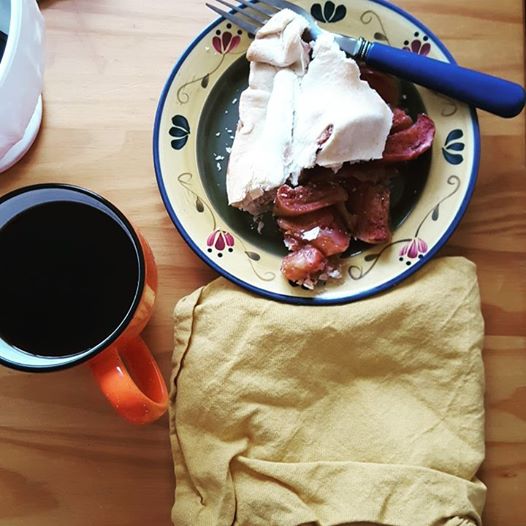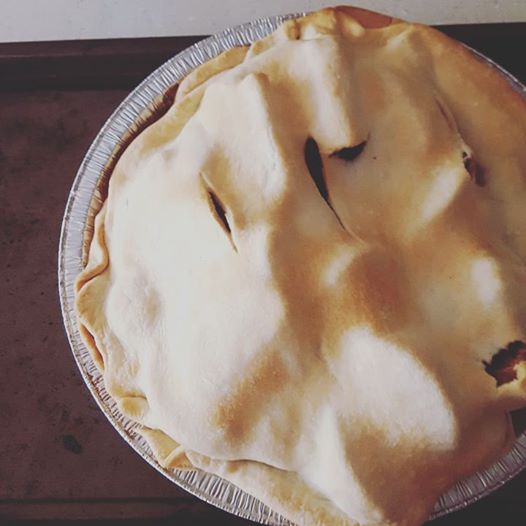
For whatever reason, I can blog without guilt.
I can’t do much else without guilt right now-if I’m at home, I feel like I should be cleaning, packing, or sleeping. You’ll notice eating isn’t on that list. Ha. Ha. [Now is not the time to talk about mental health and homesteading/intensifying homesteading, but I feel an entry coming on at some point.] I can’t even unwind with a movie or a book for a few hours without feeling like I’m wasting valuable time. We went to a free Shawn Lennon concert…do you think I could relax enough to recharge? Of course not.
But blogging seems to be ‘productive’ enough to let me unwind a little and regroup without kicking the guilt into gear.
This may be a 101 entry-but there are several situations that I can think of without really trying as to why you would be looking for information on stocking a basic kitchen. Fires, fast/long moves [quickly or across country, or both], first households, natural disasters are all situations where you might find yourself suddenly having to flip a kitchen with little guidance. If this isn’t the first household you’ve set up, this will be easier, but if you’re finding yourself interested in hearthcraft and have no idea where to begin, this will hopefully be helpful.
-Buy the best you can afford, and upgrade if you can
I feel like all of my lists lately have an entry that I mentally label ‘the cloth toilet paper’ entry. It’s the point where I feel like if I’m going to get any push back, it’s going to be that entry. What I mean here is really literal-whatever your price range is, buy the best you can at that point and then upgrade from there. You can almost always upgrade [or not, if the pieces you have are completely functional and holding out fine for you]. Here’s the thing, though-I am fully aware, having lived that reality, that the dollar store is sometimes your current price point. The dollar store is actually good for starter pieces, as long as your careful with the plastics. They’re flimsy and not going to go for years-but they’re cheap and available.
-Use your thrift stores
This is a great option if you have them available. The same idea applies to garage sales, estate sales, and the like.
I have a thing for measuring spoons with molded/raised size markers. I have destroyed more than one set of measuring spoons by washing off the markers. I can eyeball sizes fairly accurately but with canning, I don’t want to risk throwing off a recipe. I have upgraded several sets of spoons with trips to the thrift stores. I have also found small pieces of cookware, and when I was first starting out after school I bought all my plates and coffee cups at the Salvation Army. You do have to be careful with pricing-thrift stores are notoriously expensive for things like canning jars where they try to charge per piece.
-Give up form for function [or save it for gifts]
I love most of the stuff in gourmet cooking shops. I love the cookware, the amazing ladles, and the coffee makers. The only thing I really have my eyes set on, truly, are good European canning jars and a coffee maker. I spent six years working as a barista, loved it, and learned the value of a truly good brewer. However, about those ladles. I have an Oneida solid metal ladle that after 8 years of my mediocre household skills is still puttering along fine. I can’t justify the price difference to upgrade a solid metal ladle to another solid ladle just because it’s shiny and pretty.
But. There is something to be said for what could be called heirloom quality tools. And knives especially are aided by a little more money being put towards the cause. If you’re the type of person who celebrates gift giving situations, ask for these tools [or gift cards towards them] as your gift. People might think it a little odd that you want a $20 ladle, but you might get it.
-Shop beyond your normal zones [or your normal stores]
Goya sells a lot of inexpensive staple cooking supplies like spices, sofrito, and beans. In fact, a great many of the food staples in my kitchen are cheaper in ‘specialty’ sections of Wegmans or specialty stores. Target and Tops both want $5 a bottle for sesame oil for drunken noodles, whereas it’s $3 a bottle at T&T Grocers up the street, who specialize in several Southeastern Asian cuisines. In fact, I get my instant coffee strips for baking and camping at T&T-they’re less than half the price for high quality instant coffee compared to mainstream American grocers.
-Buy a cookbook
The Internet is a beautiful thing, but get a solid cookbook. Just one, to start. You can flesh out your collection once you figure out what you want to be cooking [unless you already know]. I actually like the workhorse basic Betty Crocker red and white cookbook, but Cook’s Illustrated have several huge, well tested cookbooks on the market.
-What fits your style?
Do you need a waffle maker?
This has actually been a running battle in my household for years now, and with getting a much larger kitchen in the new apartment, I fear that Mid will ultimately win this war and we’ll get a waffle maker when the Christmas sales start up. So basically tomorrow in American shopping reality.
Do not buy things just because you feel like a well rounded kitchen should have one. If you don’t see yourself using it, then don’t spend the money on it. It causes clutter and eats up money. I do feel like you should have a good quality stand mixer, preferably one you can get attachments for like a Kitchenaide or similar. But I honestly can’t think of anything you need beyond that. You can live without a microwave, you don’t need a toaster oven, and I know that even my beloved coffee makers are optional.
Unless of course you actually do need those things in your household. Then get them, but ignore the waffle makers of your world.
-Multitasking items
I used my graniteware canner so infrequently as a canner and so frequently to corral kitchen cloth that during one of the waves of purges over the past two months getting ready for this move I got rid of it. I use a stockpot for most of my water bath canning. And the beauty of it is that I use the pot for more ‘normal’ pot things. Buy items that you can get more than one use out of.
-Out of the box and into the basket
One of the very, very few things I do enjoy about moving is finding the farmer’s markets and CSAs. I…have never actually subscribed to one but I like to find them and daydream. And then forget about actually signing up because I almost always find them in January when all we’re growing is lake effect snow. I do have friends however that swear by them, and for someone like me who now works Saturdays during most farmer’s markets, it might be on my to do list for next summer so I can still get my local produce without scheduling conflicts.
-Give up on matching
Pick a color. Or a color family. Or a generic print family like ‘flowers’ or ‘fruit’ or ‘flamingos’. Great. You now have your kitchen theme. My theme for the new kitchen is fall colors and harvest themes-fruit, pumpkins, golds, dusty jewel tones to pull in the colors from the living room. So now that I have a rough idea in my head I can mix and match items that I find on sale or are gifted without trying to fit things I find on sale into my kitchen without throwing off the visual of the place. You don’t need to give up personal style or your budget, you just have to be flexible with what you’re willing to work with [this is also why my Kitchenaide is egg shell white. It was less than half price because the color was discontinued.]
-Shop online
I buy my loose leaf tea in bulk via Adaigo. I know people who swear by Mountain Rose Herbs. I actually ordered both my bed and my mattress online (which I understand is not a kitchen item but you get the point). Don’t be afraid to shop online for good sales on items that you don’t need in the immediate short term. You can often get good sales on bulk items like spices, and you will most likely be able to get access to supplies you can’t get locally-I can get a lot of herbs at Penzey’s down the road, but I can’t get dried scorpion peppers or Carolina Reapers, like I can online.














